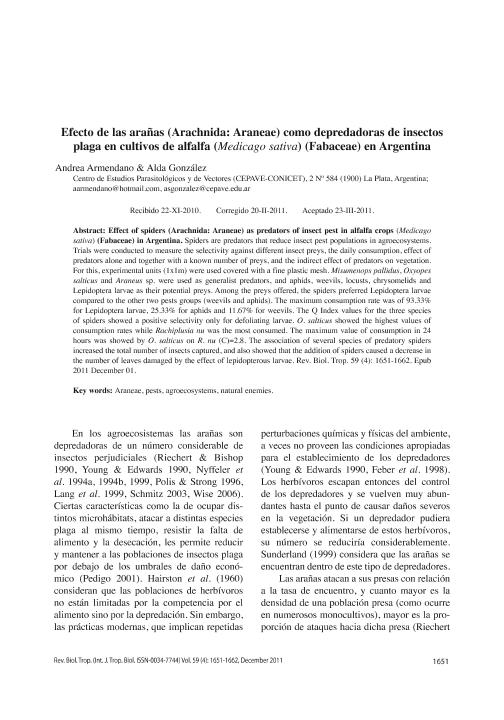Artículo
Efecto de las arañas (Arachnida: Araneae) como depredadoras de insectos plaga en cultivos de alfalfa (Medicago sativa) (Fabaceae) en Argentina
Título:
Effect of spiders (Arachnida: Araneae) as predators of insect pest in alfalfa crops (Medicago sativa) in Argentina
Fecha de publicación:
12/2011
Editorial:
Revista de Biología Tropical
Revista:
Revista de Biología Tropical
ISSN:
0034-7744
Idioma:
Español
Tipo de recurso:
Artículo publicado
Clasificación temática:
Resumen
Effect of spiders (Arachnida: Araneae) as predators of insect pest in alfalfa crops (Medicago sativa) (Fabaceae) in Argentina. Spiders are predators that reduce insect pest populations in agroecosystems. Trials were conducted to measure the selectivity against different insect preys, the daily consumption, effect of predators alone and together with a known number of preys, and the indirect effect of predators on vegetation. For this, experimental units (1x1m) were used covered with a fine plastic mesh. Misumenops pallidus, Oxyopes salticus and Araneus sp. were used as generalist predators, and aphids, weevils, locusts, chrysomelids and Lepidoptera larvae as their potential preys. Among the preys offered, the spiders preferred Lepidoptera larvae compared to the other two pests groups (weevils and aphids). The maximum consumption rate was of 93.33% for Lepidoptera larvae, 25.33% for aphids and 11.67% for weevils. The Q Index values for the three species of spiders showed a positive selectivity only for defoliating larvae. O. salticus showed the highest values of consumption rates while Rachiplusia nu was the most consumed. The maximum value of consumption in 24 hours was showed by O. salticus on R. nu (C)=2.8. The association of several species of predatory spiders increased the total number of insects captured, and also showed that the addition of spiders caused a decrease in the number of leaves damaged by the effect of lepidopterous larvae.
Palabras clave:
Araneae
,
Pest
,
Agroecosistemas
Archivos asociados
Licencia
Identificadores
Colecciones
Articulos(CEPAVE)
Articulos de CENTRO DE EST.PARASITOL.Y DE VECTORES (I)
Articulos de CENTRO DE EST.PARASITOL.Y DE VECTORES (I)
Citación
Armendano, Andrea Viviana; Gonzalez, Alda; Efecto de las arañas (Arachnida: Araneae) como depredadoras de insectos plaga en cultivos de alfalfa (Medicago sativa) (Fabaceae) en Argentina; Revista de Biología Tropical; Revista de Biología Tropical; 59; 4; 12-2011; 1651-1662
Compartir
Altmétricas




